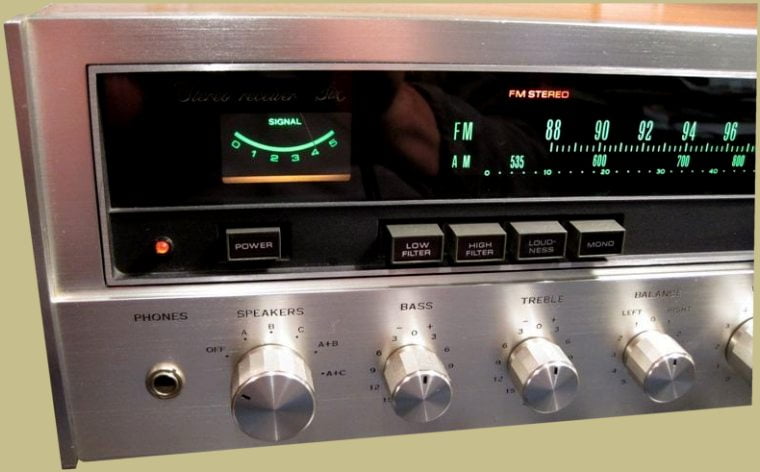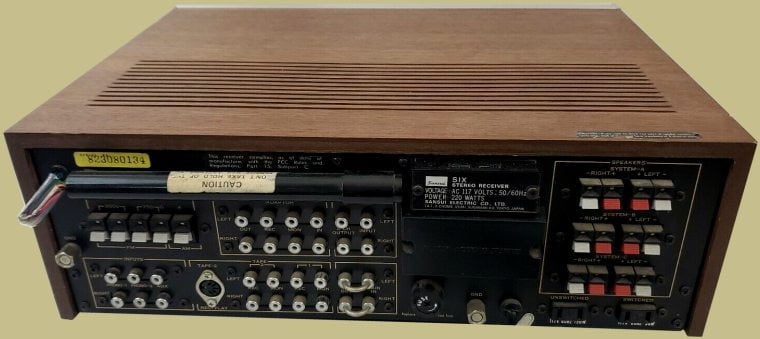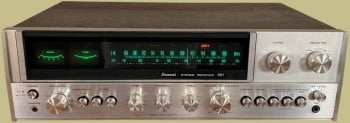
The Sansui Six Am/FM stereo receiver was produced from 1972 to around 1974. It retailed for $399.99. It was the smallest of Sansui’s single digit receivers and produced 34 watts per channel into 8 ohms. It also produced a very impressive 0.3% harmonic distortion.

The Sansui Seven, Eight and Eight Deluxe had more power and more features than the Six but the Six is a very well built receiver with plenty of power for a small room. It has an attractive wood case and aluminum face plate. The 4-gang FM tuner is very good.

One drawback to the Sansui Six receiver are the labels on the buttons. The glue holding them on tends to dry out over the years and they fall off. However, there are replacements that can usually be found on eBay HERE.

The Sansui Six has a number of features that aren’t often found in small receivers. Dual phono inputs are one. Pre out/main in jacks, engraved writing on the face plate and indented tone controls are some others. And, as I mentioned above it has a real wood case. It also has provisions for a noise reduction adapter (Dolby) and a 4-channel adapter as well.

The Six was made in Japan and is all hand soldered. The amp boards and EQ board are socketed which makes it much easier to work on. The tone controls use selectors with fixed resistors as opposed to potentiometers which is another advantage.

The general consensus is that the Sansui Six has a detailed and refined sound that is both musical and punchy. The bass is not deep but is very fast and defined. A three-stage direct-coupled low-noise equalizer and a completely direct-coupled OCL pure complementary power amplifier help in this regard.

Overall, the Sansui Six is a great receiver for a smaller room. It is reasonably priced as well at around $300 to $400 for a nice working unit.


I bought a broken Six for about $100 and it was an absolute joy to work on — every board is either socketed or easily accessible by simply unscrewing. In my opinion, it’s one of the most beautifully constructed and laid-out receivers ever made. The chassis has quite a bit of heft, and the faceplate is absurdly thick. People are always surprised when they pick it up — way heavier than it looks! Bass and treble tone controls are stepped attenuators (hand-soldered!) rather than pots, which is great as well. Some PSU transistors should be swapped, as should the low-power transistors on the phono and preamp boards, but otherwise these things are fairly bulletproof. Glad the Six finally got an entry on the site.
Very interesting! Thanks for the insights.
Hi Alex – I have a six with a bad channel module (F-1439). It has low output even at max volume. Is this something you could repair or offer assistance on?
I’ve had a Sansui Eight in my collection for several years and it is among my favorites. When a Six went up on CL for $200 I quickly grabbed it. Was super nice with all lights functioning and all controls working and static free. All labels still on buttons and overall beautiful with only a couple scratches on top of case and the top of the metal front trim. Set it up with a pair of recently purchased Wharfedale W25 speakers and the sound of this combination was incredible. Better than I had hoped for and am very pleased.
le mien a été réchapper au complet et je l’utilise avec une paire de Polk audio sda 2a je n’ai rien entendu de mieux nulle part !!
mine was recapped completely and I use it with a pair of Polk audio sda 2a I haven’t heard anything better anywhere!!
The Sansui Six has a great tuner, excellent phono section, plenty of inputs, and is built like a tank. I have had many receivers over the years and it’s one of the very best, regardless of power output. Basically, it has the build quality and features of a top-of-the-line receiver in a small package, and the rated 28 watts per channel sound like 48. It will drive medium-efficiency speakers to loud levels in small and medium-sized rooms. Most important is sound quality, and everything sounds good through it, whether it’s analog or digital. To say this thing is impressive is an understatement. I’d put it up against anything in the 30 watts per channel and below receiver category.
One other note about the Sansui Six: this site lists the power of this receiver as 34wpc, which is true at 1k Hz, but from 20 to 20k Hz, it’s rated at 28 watts per channel (I have the original brochure and operating instructions). Either way, this little gem is completely overbuilt and sounds like much more (and probably is). Its sonics and FM performance compare favorably to similarly-powered Marantz receivers from the same era. If only most monster receivers sounded as good as the Sansui Six!
Anyone compare with the 2000x model?